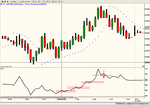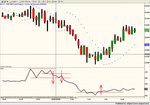Andy,
No (not part of Advanced GET). Just under Formulas/EFS2/Custom/customVolume.efs. You also get the same multiple time frame capability for studies such as OBV. In other words, you could have a 10 minute OBV on a 1 minute chart.
Simplistic.. well, even if it was (and fwiw, I don't think it necessarily is) it doesn't matter as long as it suits you. In its favour, it would seem to highlight the majority of lower volume pull backs during trends and would also seem to highlight certain divergences.
Practically speaking, if it does have a problem, it's that it is based on a fixed time frame or fixed time slots. Since a difference of two ticks on ES (i.e, the difference between a bar closing up or down) will completely reverse the OBV reading, I would imagine the time frame in which you viewed it would become critical.
You are obviously comfortable with 10 minute bars and the information that you get from that. I find 10 minutes a strange time frame for all sorts of reasons, but I know Skim used to use it and again, it's what suits you that matters.


